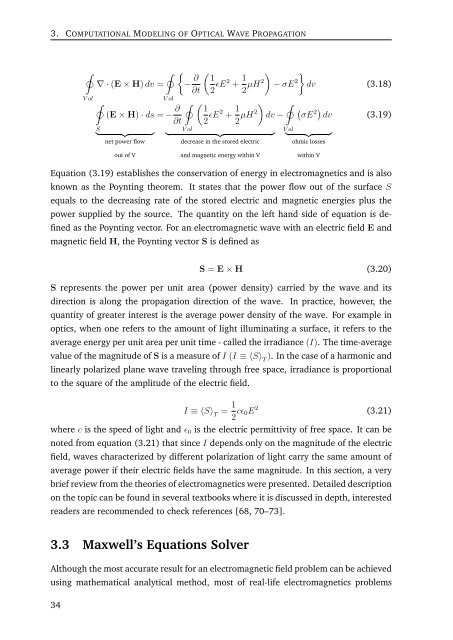Rahul Dewan - Jacobs University
Rahul Dewan - Jacobs University
Rahul Dewan - Jacobs University
Create successful ePaper yourself
Turn your PDF publications into a flip-book with our unique Google optimized e-Paper software.
3. COMPUTATIONAL MODELING OF OPTICAL WAVE PROPAGATION<br />
˛<br />
˛<br />
∇ · (E × H) dv =<br />
V ol<br />
˛<br />
V ol<br />
(E × H) · ds = − ∂ ˛<br />
∂t<br />
{<br />
− ∂ ( 1<br />
∂t 2 ɛE2 + 1 ) }<br />
2 µH2 − σE 2 dv (3.18)<br />
( 1<br />
2 ɛE2 + 1 ) ˛<br />
2 µH2 dv −<br />
(<br />
σE<br />
2 ) dv<br />
(3.19)<br />
S<br />
} {{ }<br />
net power flow<br />
out of V<br />
V ol<br />
} {{ }<br />
decrease in the stored electric<br />
and magnetic energy within V<br />
V ol<br />
} {{ }<br />
ohmic losses<br />
within V<br />
Equation (3.19) establishes the conservation of energy in electromagnetics and is also<br />
known as the Poynting theorem. It states that the power flow out of the surface S<br />
equals to the decreasing rate of the stored electric and magnetic energies plus the<br />
power supplied by the source. The quantity on the left hand side of equation is defined<br />
as the Poynting vector. For an electromagnetic wave with an electric field E and<br />
magnetic field H, the Poynting vector S is defined as<br />
S = E × H (3.20)<br />
S represents the power per unit area (power density) carried by the wave and its<br />
direction is along the propagation direction of the wave. In practice, however, the<br />
quantity of greater interest is the average power density of the wave. For example in<br />
optics, when one refers to the amount of light illuminating a surface, it refers to the<br />
average energy per unit area per unit time - called the irradiance (I). The time-average<br />
value of the magnitude of S is a measure of I (I ≡ 〈S〉 T<br />
). In the case of a harmonic and<br />
linearly polarized plane wave traveling through free space, irradiance is proportional<br />
to the square of the amplitude of the electric field.<br />
I ≡ 〈S〉 T<br />
= 1 2 cɛ 0E 2 (3.21)<br />
where c is the speed of light and ɛ 0 is the electric permittivity of free space. It can be<br />
noted from equation (3.21) that since I depends only on the magnitude of the electric<br />
field, waves characterized by different polarization of light carry the same amount of<br />
average power if their electric fields have the same magnitude. In this section, a very<br />
brief review from the theories of electromagnetics were presented. Detailed description<br />
on the topic can be found in several textbooks where it is discussed in depth, interested<br />
readers are recommended to check references [68, 70–73].<br />
3.3 Maxwell’s Equations Solver<br />
Although the most accurate result for an electromagnetic field problem can be achieved<br />
using mathematical analytical method, most of real-life electromagnetics problems<br />
34

















